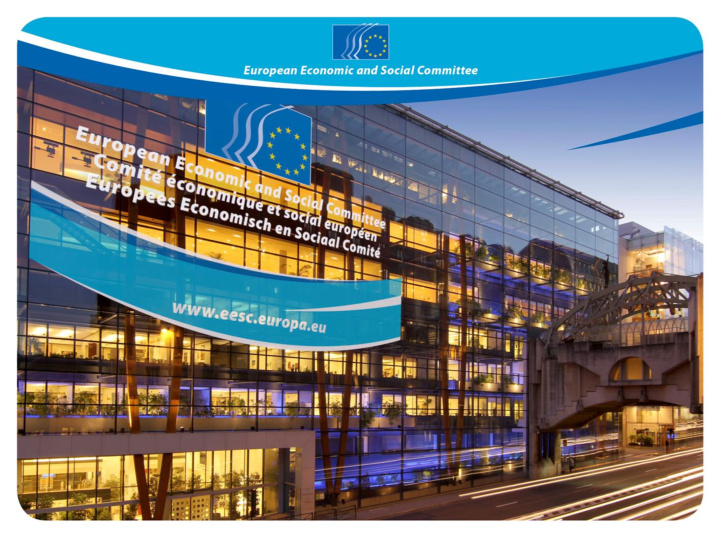



What is the EESC? A consultative body that represents Civil Society “ The European Parliament, the Council and the Commission shall be assisted by an Economic and Social Committee and a Committee of the Regions acting in an advisory capacity . ” Treaty on European Union, Art. 13
Where is the EESC located? European Commission European Council Parliament of the EU
More than half a century of experience 2007 By recognising participatory • • 1957 The EESC is established by the Rome democracy alongside Treaties representative democracy, the 1986 The Single European Act further • Lisbon Treaty strengthens the develops the EESC ’ s role EESC's role as intermediary • 1989 The EESC issues the opinion that between organised civil society and inspired the Community Charter of EU decision-makers. Fundamental Social Rights • 1992 The Maastricht Treaty broadens the scope of EESC consultations 1997 The Amsterdam Treaty grants the EESC • the right to be consulted by the European Parliament 2001 The Nice Treaty further extends the • range of policy areas on which the EESC must be consulted
Number of EESC Members by country 9
Our vision: European values • freedom, democracy and equality • global solidarity, social justice • environmental responsibility
Consultative Commission on Industrial Change (CCMI) • The Consultative Commission on Industrial Change (known by its French acronym of CCMI, Commission consultative des mutations industrielles) examines changes in industry across a wide range of sectors, keeping pace and tackling them according to the values of the European economic and social model. • The CCMI succeeded the consultative committee of the ECSC (European Coal and Steel Community) when the latter expired on 23 July 2002. It is established as a distinct body within the EESC and has a remit extended to all sectors of industry in both manufacturing and services.
EC & CCMI Partnership Public Awareness Campaign
Opinions of EESC related with the mining policies Indigenous coal in the EU energy transition The processing and exploitation, for economic and environmental purposes of the industrial and mining waste deposits from European Union Secondary raw materials Tackling the challenges in commodity markets and on raw materials The raw materials initiative: needs for growth and jobs in Europe Non-energy mining industry in Europe
Coal mining-potential job losses until 2025 Source: European Commission
Share of electricity from coal in the generation fuel mix Source: Energy Community
South – East EU coal mining regions
Romania • 77 mine tailings with a total volume of 340 millions of cubic meters, covering a surface of 1700 ha • 675 mine waste dumps with a total volume of 3.1 billion cubic meters, covering 9300 ha
Indigenous lignite power in Romania able to provide 30% of the electricity consumption in the National Power System producer of more than 95% of the Romanian Lignite provides job for about 13 300 employees
Indigenous hard coal power in RO Hunedoara Energy Complex provides about 2% of Romania's electricity production Proven reserves for at least 80 years Staff number: about 4,081 employees
COM (2019) 285 final 18.06.2019 The Commission’s proposal for the next multi-annual financial framework 2021 – 2027 forsee that at least 25 % of Union funds should contribute to support climate mitigation and adaptation
TOOLS FOR A JUST ENERGY TRANSITION • Social dialogue at European and national level • EU Platform for coal regions in transition • National Energy and Climate Plans • A dedicated fund for just transition
GLOBAL GOVERNANCE FOR A JUST ENERGY TRANSITION 75 % of the world population 90% of the Gross World Product 80% of the world trade 50 % of the land area
Follow us! It’s about Europe, it’s about YOU! www.eesc.europa.eu EESC - European Economic and Social Committee @EU_EESC EurEcoSocCommittee
Recommend
More recommend